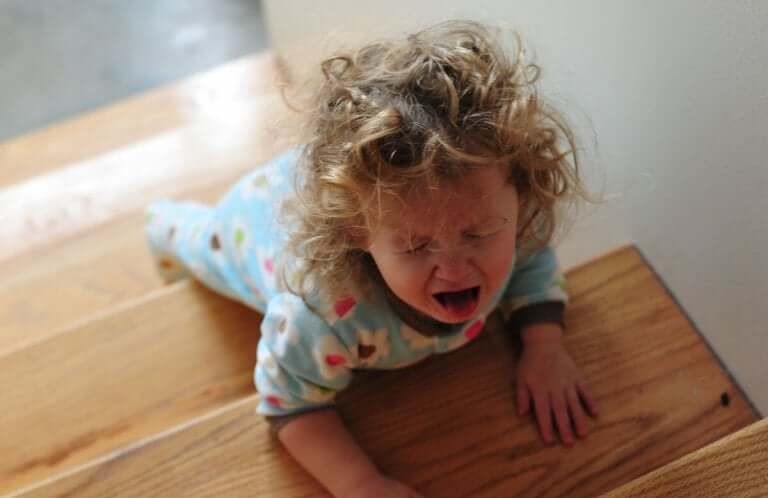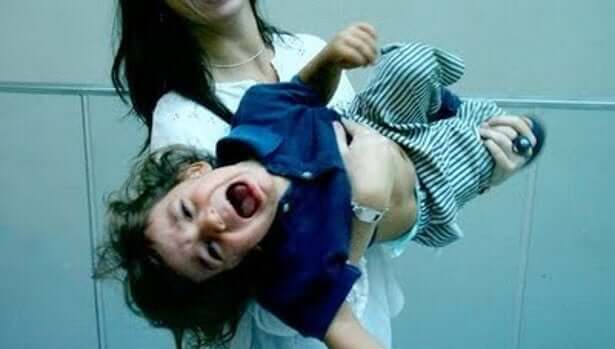How to Deal with a Child's Temper Tantrums

A reaction of intense anger, expressed through screaming, crying, and aggressive behavior (hitting or beating oneself, throwing things, throwing oneself on the ground, etc.) is, as we all know, defined as a tantrum. Parents may find it very difficult to deal with their child’s temper tantrums in certain situations.
Approximately half of all children exhibit such disruptive behavior on a regular basis. Adults often try to deal with them by improvising, but there’s always the possibility that their methods may not always work. This can leave the caregiver feeling helpless, and even emotionally overwhelmed.
In order to deal with children’s tantrums, it’s essential to remain calm and even ignore what’s going on. However, there are situations that spiral completely out of control and that require intervention.
Causes of tantrums in children
In the first five years of a child’s life, behavior has a mainly exploratory function. This stage is characterized by an autonomy that a child acquires progressively through trial and error. This entails a great deal of motor activity, which is encouraged or allowed by adults, who are aware of its importance.

During this time, children create their own rules of conduct, which don’t necessarily coincide with those established by society. They’re instinctive rules that lead to learning when they explore their surroundings.
In this process, the adult takes on the role of protector, as he or she has to ensure the safety of the child as they adapt to each situation. They’ll impose limits and help the children to acquire self-regulation of their own behavior, based on pre-established rules.
At this stage in their lives, children will start to throw tantrums. This is their way of showing nonconformity and rebellion towards what they interpret as a veto on their freedom to learn.
However, there are different reasons behind this type of behavior:
- A normal consequence of evolutionary development.
- Reactive rebellious behavior, where you’ll need to set limits in an appropriate way.
- Evidence of a future psychopathology, and you’ll need to visit a mental health specialist.
Factors that influence the appearance of tantrums
All external behavior is the visible aspect of the internal cognitive and emotional processes that are taking place in a child’s life. Behavior is influenced by different factors that combine to create a certain reaction. Some of these factors are:
- Temperament. This is genetically transmitted and is determined by the response to anxiety, impulsiveness, mood, and the ability to enjoy things.
- Character. This is modeled through experience, with the help of parents, teachers and other adults. It’s made up of will, responsibility, commitment, objectivity, honesty, courage, etc.
- Emotions. These are passing internal states, which can be either positive or negative, and give rise to feelings (permanent internal states).
- Attributional. This is the child’s ability to recognize the responsibility of their actions, and accept that there are consequences.
- Self-regulation. This refers to children’s ability to resist their innate impulses, control their behavior, and adapt to social norms.
Tips for dealing with a child’s temper tantrums
How we deal with a child’s first tantrums is very important. If we do it in the correct way, then we’ll be able to eradicate this behavior after a while. However, as we’ve already said, the success of our methods will depend on the child’s temperament.
A tantrum is an explosion of energy produced by a frustrating situation, which tends to extinguish itself if the fire isn’t “stoked up.” However, keeping ourselves out of the situation (or preventing other adults from intervening) is a big challenge.
Anticipating the causes of tantrums
The most effective way to control a child’s temper tantrums is to prevent them from happening in the first place. To anticipate this situation, we must be alert and detect what factors usually cause it to appear. We must observe factors such as:
- Times when the child can react more strongly
- If the child is sleepy, hungry, tired, bored, hot, or cold, etc.
- Their physical activity throughout the day
- The time they’ve spent playing on devices, and what kinds
- If the house or place they spend time in is very noisy or over-stimulating
- If they’re nervous or afraid of something
- Our attitude to a conflict with the child. Do we let them express themselves? Are we anxious, rigid, or intolerant towards them? Do we listen to what they’re saying, or do we ignore them and say we’ll deal with them later.
- And, in general, all the other factors that can help us determine what makes the child lose their self-control.
Once we’ve determined what’s causing this explosion of frustration in the child, we have to try to control the situation and the relevant factors as much as possible, in order to try to avoid these situations.

Tips for getting rid of a child’s temper tantrums
If, despite all your efforts to prevent tantrums, you don’t succeed, here are some more tips to help you deal with your child’s temper tantrums:
- Don’t intervene until you can see that the child’s frustration is dying down on its own. Be careful not to endanger yourself or anyone else.
- Stay calm, because acting in an aggressive way towards the child can produce the opposite reaction in them. You’ll be teaching them that the use of aggression is the way to solve complicated situations.
- Take the child out of the situation if other adults try to intervene, or if the situation becomes very uncomfortable.
- Address the child in a friendly way, controlling your non-verbal language and conveying a friendly message.
- When they’ve calmed down, explain how ineffective their tantrums are in achieving their goals.
- Don’t blame them. Remember that they may not have obtained their full ability to self-regulate themselves.
- Practice relaxation and do daily exercise to help regulate their adrenaline levels.
A reaction of intense anger, expressed through screaming, crying, and aggressive behavior (hitting or beating oneself, throwing things, throwing oneself on the ground, etc.) is, as we all know, defined as a tantrum. Parents may find it very difficult to deal with their child’s temper tantrums in certain situations.
Approximately half of all children exhibit such disruptive behavior on a regular basis. Adults often try to deal with them by improvising, but there’s always the possibility that their methods may not always work. This can leave the caregiver feeling helpless, and even emotionally overwhelmed.
In order to deal with children’s tantrums, it’s essential to remain calm and even ignore what’s going on. However, there are situations that spiral completely out of control and that require intervention.
Causes of tantrums in children
In the first five years of a child’s life, behavior has a mainly exploratory function. This stage is characterized by an autonomy that a child acquires progressively through trial and error. This entails a great deal of motor activity, which is encouraged or allowed by adults, who are aware of its importance.

During this time, children create their own rules of conduct, which don’t necessarily coincide with those established by society. They’re instinctive rules that lead to learning when they explore their surroundings.
In this process, the adult takes on the role of protector, as he or she has to ensure the safety of the child as they adapt to each situation. They’ll impose limits and help the children to acquire self-regulation of their own behavior, based on pre-established rules.
At this stage in their lives, children will start to throw tantrums. This is their way of showing nonconformity and rebellion towards what they interpret as a veto on their freedom to learn.
However, there are different reasons behind this type of behavior:
- A normal consequence of evolutionary development.
- Reactive rebellious behavior, where you’ll need to set limits in an appropriate way.
- Evidence of a future psychopathology, and you’ll need to visit a mental health specialist.
Factors that influence the appearance of tantrums
All external behavior is the visible aspect of the internal cognitive and emotional processes that are taking place in a child’s life. Behavior is influenced by different factors that combine to create a certain reaction. Some of these factors are:
- Temperament. This is genetically transmitted and is determined by the response to anxiety, impulsiveness, mood, and the ability to enjoy things.
- Character. This is modeled through experience, with the help of parents, teachers and other adults. It’s made up of will, responsibility, commitment, objectivity, honesty, courage, etc.
- Emotions. These are passing internal states, which can be either positive or negative, and give rise to feelings (permanent internal states).
- Attributional. This is the child’s ability to recognize the responsibility of their actions, and accept that there are consequences.
- Self-regulation. This refers to children’s ability to resist their innate impulses, control their behavior, and adapt to social norms.
Tips for dealing with a child’s temper tantrums
How we deal with a child’s first tantrums is very important. If we do it in the correct way, then we’ll be able to eradicate this behavior after a while. However, as we’ve already said, the success of our methods will depend on the child’s temperament.
A tantrum is an explosion of energy produced by a frustrating situation, which tends to extinguish itself if the fire isn’t “stoked up.” However, keeping ourselves out of the situation (or preventing other adults from intervening) is a big challenge.
Anticipating the causes of tantrums
The most effective way to control a child’s temper tantrums is to prevent them from happening in the first place. To anticipate this situation, we must be alert and detect what factors usually cause it to appear. We must observe factors such as:
- Times when the child can react more strongly
- If the child is sleepy, hungry, tired, bored, hot, or cold, etc.
- Their physical activity throughout the day
- The time they’ve spent playing on devices, and what kinds
- If the house or place they spend time in is very noisy or over-stimulating
- If they’re nervous or afraid of something
- Our attitude to a conflict with the child. Do we let them express themselves? Are we anxious, rigid, or intolerant towards them? Do we listen to what they’re saying, or do we ignore them and say we’ll deal with them later.
- And, in general, all the other factors that can help us determine what makes the child lose their self-control.
Once we’ve determined what’s causing this explosion of frustration in the child, we have to try to control the situation and the relevant factors as much as possible, in order to try to avoid these situations.

Tips for getting rid of a child’s temper tantrums
If, despite all your efforts to prevent tantrums, you don’t succeed, here are some more tips to help you deal with your child’s temper tantrums:
- Don’t intervene until you can see that the child’s frustration is dying down on its own. Be careful not to endanger yourself or anyone else.
- Stay calm, because acting in an aggressive way towards the child can produce the opposite reaction in them. You’ll be teaching them that the use of aggression is the way to solve complicated situations.
- Take the child out of the situation if other adults try to intervene, or if the situation becomes very uncomfortable.
- Address the child in a friendly way, controlling your non-verbal language and conveying a friendly message.
- When they’ve calmed down, explain how ineffective their tantrums are in achieving their goals.
- Don’t blame them. Remember that they may not have obtained their full ability to self-regulate themselves.
- Practice relaxation and do daily exercise to help regulate their adrenaline levels.
All cited sources were thoroughly reviewed by our team to ensure their quality, reliability, currency, and validity. The bibliography of this article was considered reliable and of academic or scientific accuracy.
- Marina JA. (2012). Guía de consejos para padres. Ed: Planeta.
- Céspedes A. Cómo manejar los problemas de conducta de tus hijos. Ed: Ediciones B.
- Luengo Martín MA. (2014). Cómo intervenir en los problemas de conducta infantiles. Ed: UNED.
- Méndez FX. (2006). Terapia psicológica con niños y adolescentes. Ed: Psicología Pirámide.
This text is provided for informational purposes only and does not replace consultation with a professional. If in doubt, consult your specialist.








